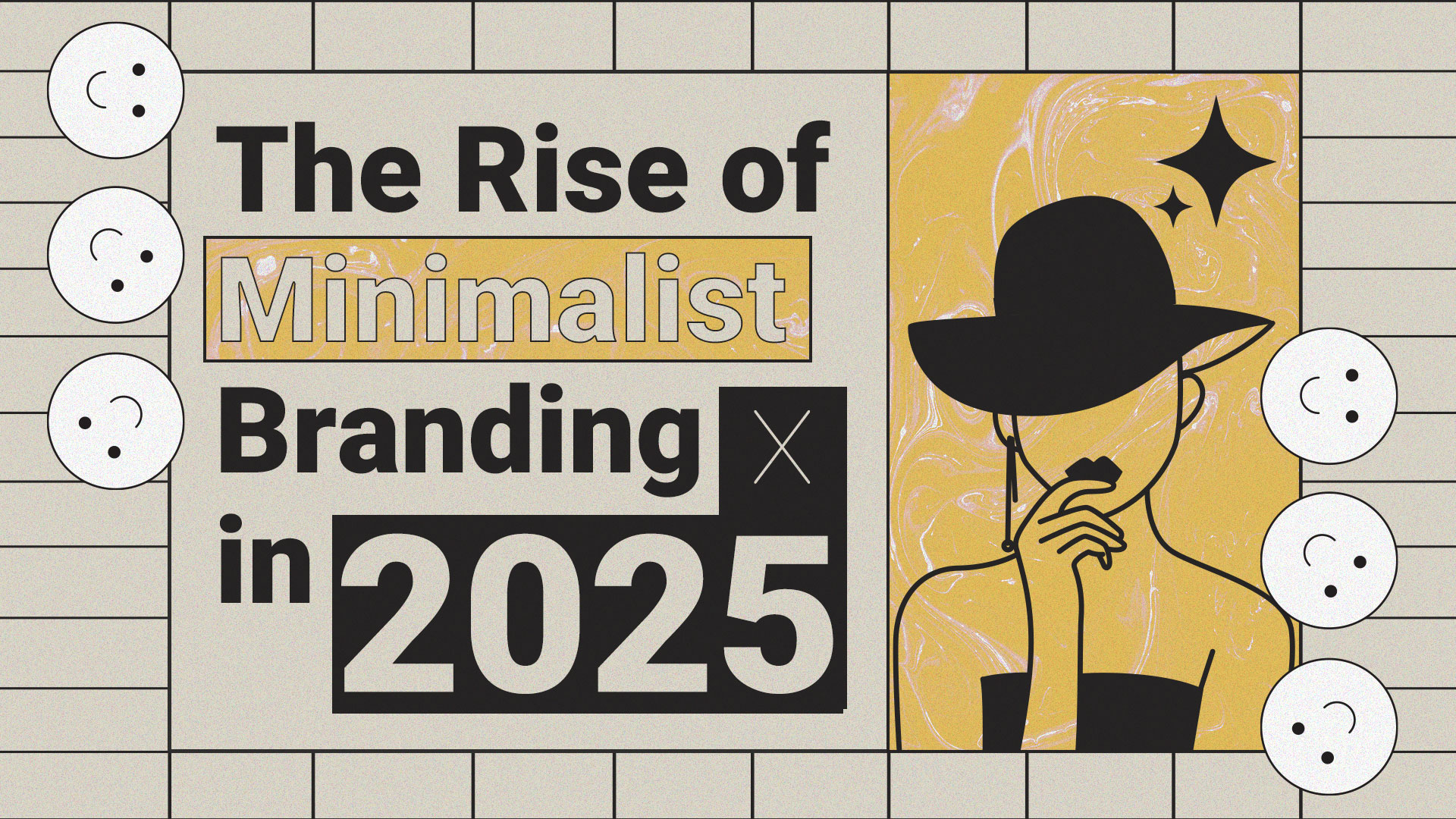When we say “less is more,” we don’t mean being boring or unattractive. It’s about being minimal and bold enough to showcase your true self. Minimalist branding is the success mantra of digital marketing trends in 2025.
Companies, from top-notch fashion brands to tech giants to startups, are focused on reducing content and digital noise from their branding. Tools like Design.com’s logo maker are becoming increasingly popular because of this design trend. It helps brands create sleek, simple designs that align with modern minimalist aesthetics.
The aim is to offer clean, authentic, and redesigned elements that enhance user experience. These should clearly communicate your brand identity and message.
Let’s discover how minimalism is reshaping branding in 2025.
How Minimalism Influences Brand Positioning
Brand positioning is a strategic approach that highlights a business’s unique value proposition and elements in such a way that it encourages customers to prefer one brand over another in a crowded marketplace.
Minimalism in brand positioning offers a clear and straightforward approach for brands to create a strong market position while making a long-lasting impression on customers.
Brands can align minimalism with broader cultural values, such as sustainability and inclusivity in diversity, and offer meaningful experiences instead of bombarding consumers with flashy advertisements and noise lacking genuine purpose.
According to a report, 62% of Gen Z customers prefer to buy products from sustainable brands.
Simply put, a brand that represents minimalism with honesty and simplicity is more likely to differentiate itself and easily connect with the audience.
Apple is a great example of a successful brand positioning created using minimalist branding.
They have brilliantly used minimalistic strategies in their product designs and marketing. Their approach revolves around simplicity, functionality, and an uncluttered user experience, positioning them as a globally recognized premium luxury brand.
 Source
Source
Visual Branding Through Minimalism
Visual aspects of a brand are the most effective medium to convey minimalism through your branding in 2025.
The idea is simple: use clean design elements, such as subtle colors, uncomplicated type settings, and easy but powerful words, to eliminate distractions and allow brands to display their outstanding brand identities.
Displaying minimalistic ideas through web page designs, logos, and graphics clarifies your branding exercises.
Minimalism in web page design
A well-designed minimal web page has enough white space, restrained color palettes, crisp typeface, and a simple layout that promotes easy navigation across multiple platforms.
Conversely, an overwhelmed web page design displays flashy colors, complicated layouts, and visually complex font styles that decrease user accessibility.
From shopping websites to official software and apps that manage company and employee data, many website builders and platforms are incorporating minimalist ideas in their user interface, visible attributes, and functionality.
For example, most organizations’ employee time tracking app adheres to simple and minimalistic design elements that highlight their core functionality of time management.
Real-world example: Kinfolk’s website design embraces minimalist design with ample white space, is visually engaging, and uses typography that conveys simplicity and elegance.
 Source
Source
Minimalist motion graphics
Motion graphics combine text, sound, images, and endless design ideas. Sometimes, this can overpower the message you intend to share with your audience.
These graphics are widely used for branding videos, advertisements, and explanatory company videos. Implementing simple readable texts, pleasing sounds, and minimalistic images brought to life can easily stand out in competitive branding.
Here’s an example of a minimalist motion graphic design that highlights top financial tips in a simplified manner:

Source
Minimalist logo design
Seventy-five percent of consumers can identify a brand by its logo. Logos with structured shapes, harmonized color schemes, and texts that speak volumes are trending in 2025.
If your brand uses a minimalist logo, customers will easily remember it and save you on your marketing efforts. Additionally, you can easily scale them up for brand modifications.
Need some inspiration? Here are some examples you can easily customize today.
 Minimalist Triangular Bird by Design
Minimalist Triangular Bird by Design

Green Minimalist Planet by Design

Minimalist Camera Photo by Design

Minimalist Wine Glass by Design

Minimalist Toucan Outline by Design

Minimalist Flying Bird by Design

Minimalist Parrot Head by Design

Minimalist Plant Spa by Design

Minimalist Gentleman Smoke by Design

Minimalist Candle Candlelight by Design
Real-world example: The Target logo is a perfect example of a minimal design logo. It is self-explanatory, uses a simple harmony of red and white colors, and is easy to remember.

Minimalist packaging
Whether it’s a small business or a premium brand, countless companies today are centered on using minimal packaging while ensuring quality and sustainability.
Every element, including package shape, size, material, and ergonomics, can elevate minimal packaging.
Real-world example: M.A.C Cosmetics has effectively adopted minimalist packaging across all its products. All products are packed in plastic black pallets, which are further placed in black carton boxes with the iconic M.A.C Cosmetics logo on the front.
Also, their “Back-to-M.A.C” initiative ensures that more than 50% of their packaging is recyclable, refillable, and reusable.
 Source
Source
Minimalism in Marketing, Advertising, and Branding
Minimalism in advertising cuts down the loud noise that often dominates the advertising landscape and helps establish a customer-brand association within seconds.
Most minimal advertisements are either humorous or intelligent. They focus on utilizing eye-catching visual elements, prioritizing important features, soothing or content-specific audio, and powerful text captions while ensuring minimalism does not mute the brand voice.
Similarly, whether online or offline, minimalism in branding is all about clarifying marketing initiatives, including brand voice and identity.
The goal is to market your brand just enough to convey your message successfully to the audience.
Brands should focus on driving direct, emotional, and relatable campaigns. Moreover, they should not contain fluff, overwhelming information, or unclear messages that might discourage user engagement.
Real-world example: The Black & Blaze minimalist ad campaign intelligently depicts a coffee cup as an ‘on’ or ‘off’ switch. It conveys a message to take a hot cup of coffee to switch on or re-energize yourself.
 Source
Source
Challenges and Considerations of Embracing Minimalism
The minimalist branding trend is here to stay in 2025, but many companies might face several challenges or need to consider critical aspects while embracing it. Here’s a look at some of them:
Lack of differentiation
If too many brands adopt a minimalist approach to branding, standing out in a crowd with uniqueness would be a difficult task. The risk of blending in with similar minimalist logo designs and elements might also create blandness in marketing.
Loss of brand identity
Some brands rooted in rich, vibrant, and colorful aspects, such as artistic designs or cultural-historical fashion, may always require loud branding initiatives.
Adopting a minimalistic approach in such branding campaigns might create a loss of connection when displaying the actual brand identity to the audience.
Difficulty in conveying complex information
Brands that need to convey comprehensive information through their branding might find the minimalist approach limiting.
For example, companies in the financial and healthcare industries might need to share complex data and facts through their branding. To share several important details via a simple approach could be quite challenging.
Perceived value
In some cases, minimalism could lead to a lack of perceived value among consumers. Brands may apply a minimalistic approach even for detailed and loud advertising campaigns.
This may be perceived by customers as a lack of brand experience and a downplaying of the brand’s product values.
Variation in minimalist identity and execution
If a brand adopts a minimal approach in its design strategy but provides an inconsistent or cumbersome service experience to its audience, it might confuse the customer and raise questions about the brand’s reputation.
The Future of Less: The Evolving Landscape of Minimalist Brand Identity
In 2025 and beyond, minimalism will undoubtedly significantly influence branding. Businesses that embrace simplicity, leverage technology, and adhere to minimalist design principles may produce compelling, innovative designs that better connect with their target audience.
Additionally, incorporating AI (artificial intelligence) and ML (machine learning) may enable designers to automate design processes, such as logo design or minimalist content generation.
This technical assistance will enable companies to create more intricate and refined branding designs while adhering to the “less is more” idea.
Are you looking to customize your design elements with a minimalistic approach? Or do you want a designer to help you with your modern branding campaigns?
DesignCrowd is the best design platform to help you design personalized logos, pages, or ideas by connecting you with a global network of designers for sophisticated projects. You can also visit Design.com if you prefer to DIY your minimalist branding.
Joy D’Cruz is a content marketing specialist currently working with SaSHunt. Joy has a keen interest in researching topics related to B2B and SaaS. He has created copy for a wide range of marketing and business topics including social media, email marketing, and career development.
Header Artwork by Khim John Blazo
Written by DesignCrowd on Monday, May 19, 2025
DesignCrowd is an online marketplace providing logo, website, print and graphic design services by providing access to freelance graphic designers and design studios around the world.

